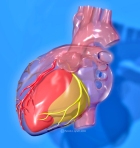««« Written by Leila Knetsch.
This is an engaging activity that helps students see how the circulatory, respiratory and digestive systems interrelate.
Materials
• Mapping Your Organs: Playing cards, chart paper and markers.
• Main Lesson: Magnetic Slates or Dry Erase Boards (or paper and colourful markers).
Distribute playing cards to the class (if you have a class of 30, set aside the extra 22 cards ahead of time). Group the students into teams of four according to the number or figure on the card (all the aces together, all the ones together, etc.).
Mapping Your Organs: Minds On (15 minutes)
Directions to the students:
- Draw an outline of the torso of one of the group members.
- Draw the respiratory, circulatory and digestive systems. Focus on how the organs inter- relate.
- Label what you can and hand it in for a debriefing later in the class.
Main lesson:
Teach a lesson (not included here) on the structures and functions of different organs and how they relate together. Ask questions (like the sample questions below) using Think-Pair-Share and Flash It (see instructions below) to increase student engagement.
Sample Questions
- What is the function of the heart?
- Why does the blood go to the lungs?
- Why are the heart and lungs near each other?
- Why does the blood go to the heart twice?
- What structure in the digestive system prevents food from going the wrong way?
- Where is the food digested?
- How do the nutrients (proteins, fats, sugars) from a hamburger get into the cells of your toe?
- What is the purpose of the alveoli?
- Why are there two lobes of the lung on one side of your body and three lobes on the other?
- How is the structure of the trachea different from the structure of the esophagus and why?
Flash It!
You can increase engagement by having every student respond to every question instead of just the most participatory five students. Distribute magnetic slates (like an Etch a Sketch) or a Dry Erase board, and ask students to sit in pairs. If you do not have access to one of these items, use scrap paper and colourful markers.
Instructions for Flash It!
1. The teacher asks a question (see sample questions below) and all students respond by writing the answers on
their Dry Erase boards or Magnetic Slates and flashing/showing it to the teacher.
2. The teacher glances around the class to check for understanding.
Think-Pair-Share
- The teacher pairs students (if there is an odd number, the teacher can be someone’s partner). One partner is
A and the other is B. - The teacher asks a question; the students think to themselves and write the answer on a dry erase board.
They then share with a partner. - The teacher calls out a random number (e.g. B12) and that student has to answer the question.
After: Consolidation and Connection (15 minutes)
Debriefing the “Mapping Your Organs” activity.
Hand back the Organ Maps and ask one representative member (person with the shortest hair or most colourful shirt) to stand up. There should be about 8 people standing. Go around the room clockwise and ask each representative to point something out about their organs that the other groups did not.
Curriculum Expectations
B3.4 Explain the primary functions of a variety of systems in animals.
B3.5 Explain the interaction of different systems within an organism and why such interactions are necessary for the organism’s survival.
Leila Knetsch is the ACL of Science at Albert Campbell CI. She is currently interested in incorporating literacy and technology into science. Leila may be reached at Leila.knetsch@tdsb.on.ca.


